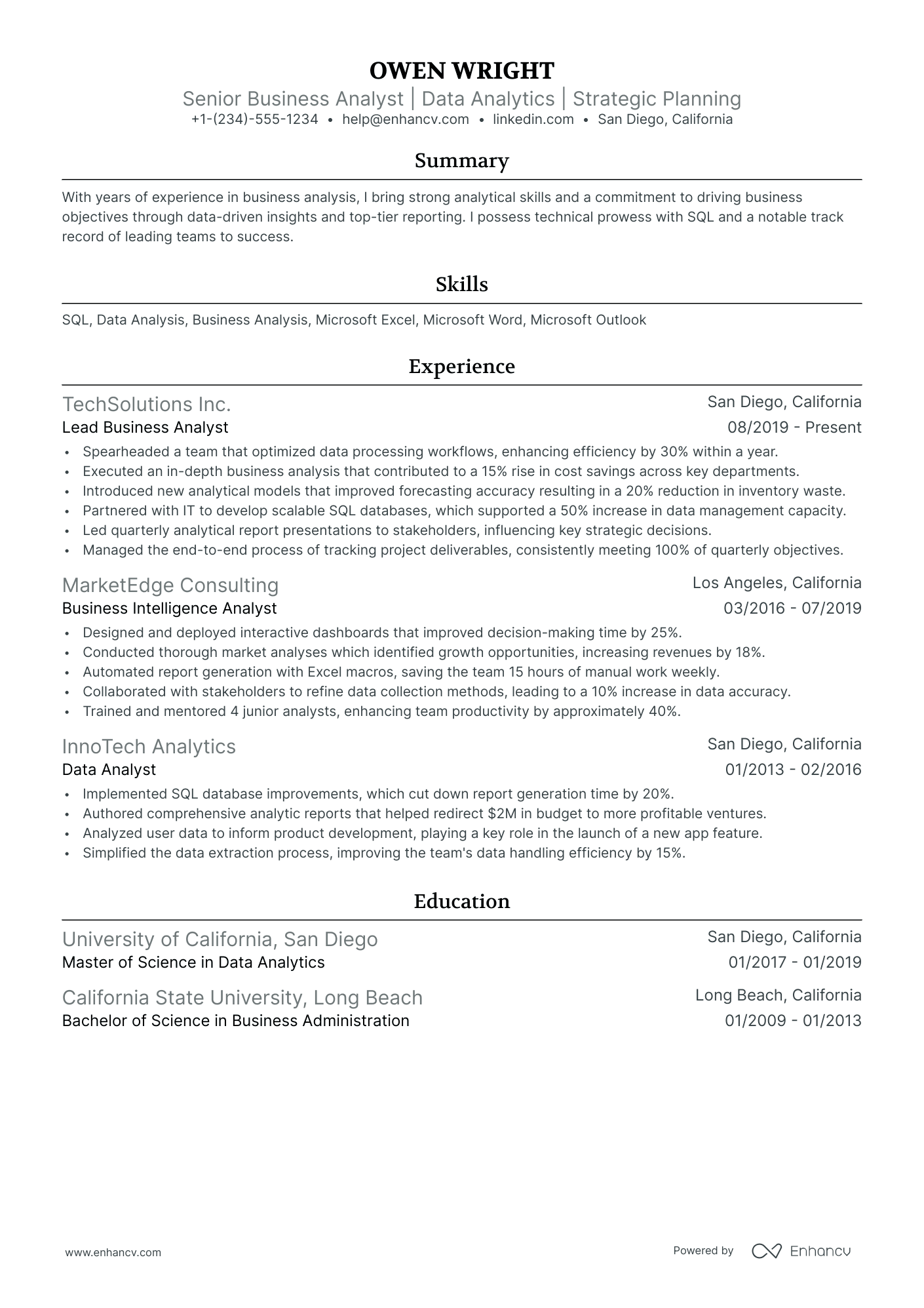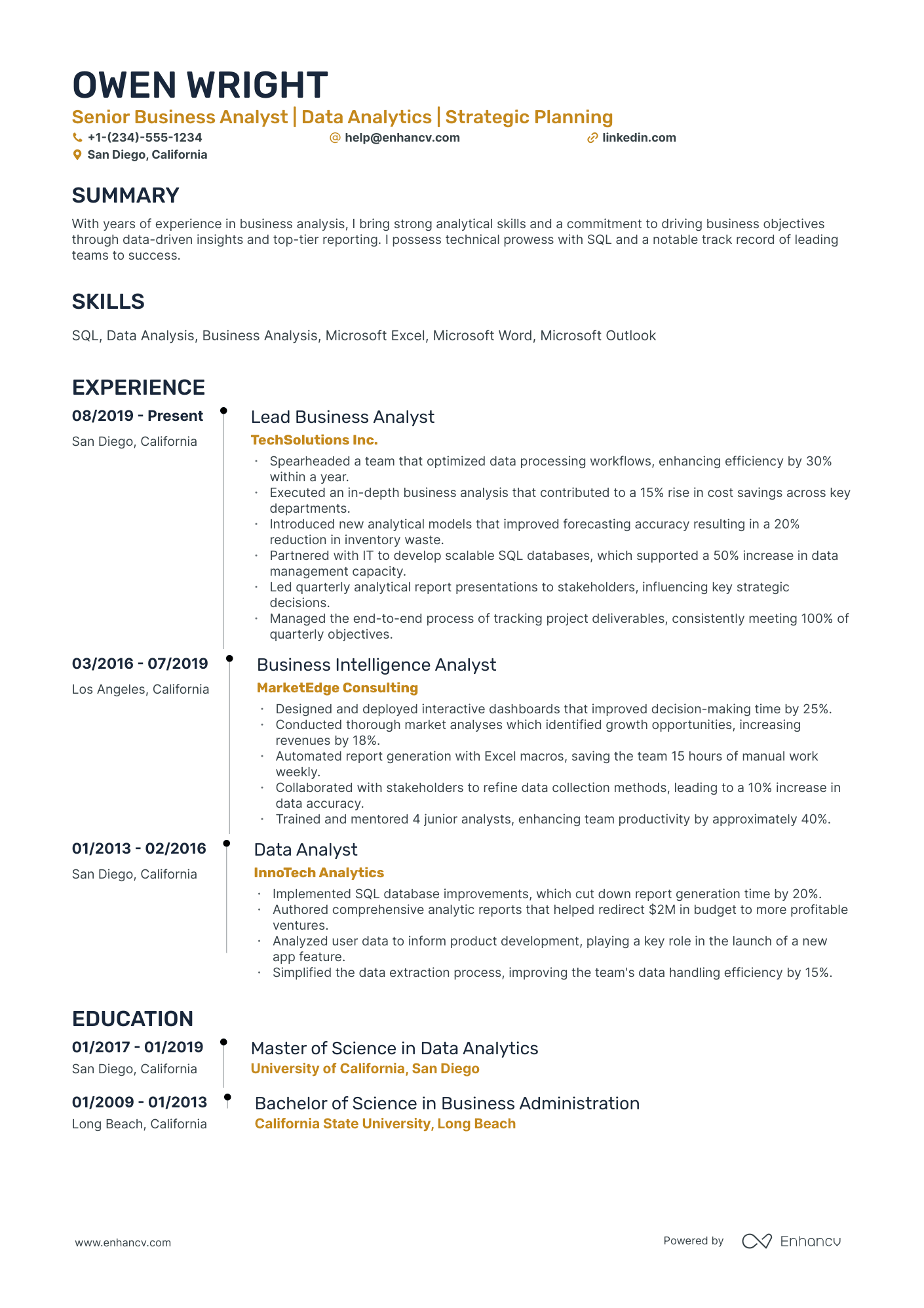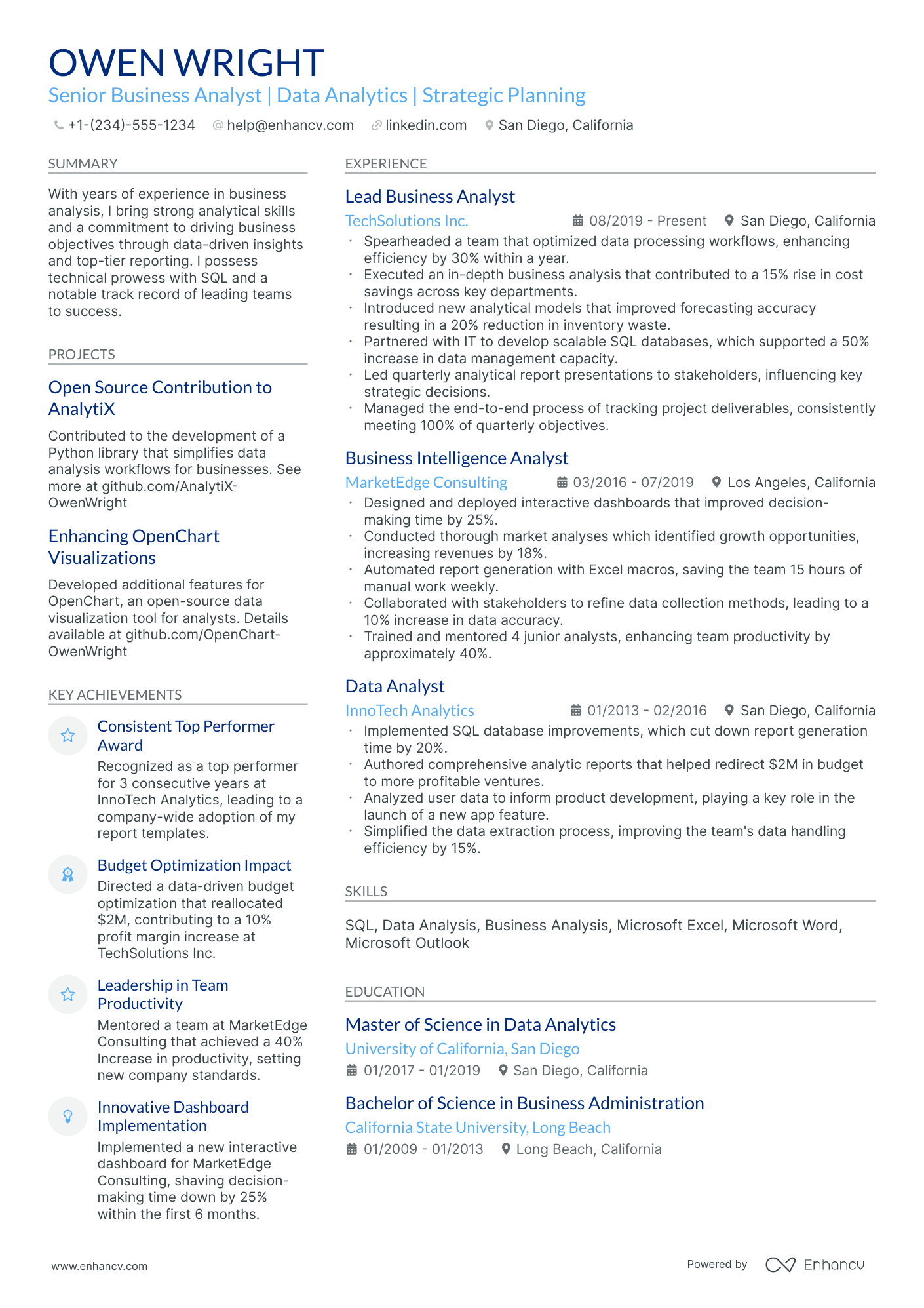As an excel data analyst, articulating your complex technical expertise and data manipulation skills in a concise resume can be challenging. Our comprehensive guide offers strategies and examples to help you distill your extensive knowledge into a compelling resume that captures the attention of hiring managers.
- Apply best practices from professional resumes to spotlight your application;
- Quantify your professional experience with achievements, career highlights, projects, and more;
- Write an eye-catching excel data analyst resume top one-third with your header, summary/objective, and skills section;
- Fill in the gaps of your experience with extracurricular, education, and more vital resume sections.
We've selected, especially for you, some of our most relevant excel data analyst resume guides. Getting you from thinking about your next career move to landing your dream job.
How to style your excel data analyst resume: layout and format
When creating your excel data analyst resume, have you ever wondered how long it should be? Experts point out that it should be between one and two pages. Choose the longer format, if you happen to have over a decade of relevant experience. What is more, resume formats play a crucial role in presenting your experience. Use the:- Reverse-chronological resume format to highlight your experience;
- Functional skill-based resume format if you have less experience and want to focus on skills;
- Hybrid resume format to guide recruiters through both your experience and skills.
- Make sure your headline is simple and includes the job you're applying for or your current role, an abbreviation of a certificate you have, or even your professional area of interest;
- Always tailor your excel data analyst resume to the role you're applying for by matching job requirements to your experience via different resume sections;
- Once you've created your resume, download it in PDF (unless otherwise specified). This is to ensure readability and that the layout remains fixed.
Different markets have specific resume formats – a Canadian resume could vary in layout.
Upload & Check Your Resume
Drop your resume here or choose a file. PDF & DOCX only. Max 2MB file size.
PRO TIP
Always remember that your excel data analyst certifications can be quantified across different resume sections, like your experience, summary, or objective. For example, you could include concise details within the expertise bullets of how the specific certificate has improved your on-the-job performance.
Don't forget to include these six sections on your excel data analyst resume:
- Header and summary for your contact details and to highlight your alignment with the excel data analyst job you're applying for
- Experience section to get into specific technologies you're apt at using and personal skills to deliver successful results
- Skills section to further highlight how your profile matches the job requirements
- Education section to provide your academic background
- Achievements to mention any career highlights that may be impressive, or that you might have missed so far in other resume sections
What recruiters want to see on your resume:
- Strong proficiency in advanced Excel functions (such as VLOOKUP, INDEX+MATCH, pivot tables, macros, and complex formulas).
- Experience with Excel data visualization tools and the ability to create clear, informative reports and dashboards.
- Knowledge of data analysis methodologies and experience in statistical analysis, forecasting, and identifying trends within large datasets.
- Experience with data cleaning, transformation, and preparation to ensure accuracy and integrity for analysis.
- Ability to automate repetitive tasks and streamline data processes using Excel VBA and other automation techniques.
The excel data analyst resume experience section: a roadmap to your expertise
The resume experience section provides you with an opportunity to tell your professional narrative.
Recruiters, reading between the lines of your resume, use the experience section to better understand your unique skill set, accomplishments, and what unique value you bring about.
Discover five quick steps on how to write your experience section:
- Curate only relevant experience items to the role and include the company, description, and dates; all followed by up to six bullets per experience item;
- Each experience item should feature tangible results of your actions - if you can include a number or percent, this will further highlight your aptitude;
- If you've received any managerial or customer feedback, use short excerpts of it as further social proof of your technical or people skills;
- Make sure you're using the appropriate verb tense when listing your responsibilities;
- Within the description for each role, you could summarize your most noteworthy and relevant achievements.
Now, take note of how a real-world excel data analyst professional received opportunities at industry leaders with these resume experience sections:
- Designed complex data models within Excel to analyze quarterly sales trends across 5 key product lines, increasing forecast accuracy by 18%.
- Automated manual reporting processes by developing advanced macros and VBA scripts, reducing report generation time by 25 hours per month.
- Collaborated with IT to integrate Excel with SQL databases, allowing for real-time data pulls that supported dynamic reporting capabilities.
- Managed large datasets in Excel for market analysis, identifying key growth opportunities that contributed to a 10% increase in market share.
- Conducted in-depth cost-benefit analysis using pivot tables and conditional formatting to support strategic investment decisions for new product development.
- Spearheaded the transition from Excel 2010 to Office 365, training a team of 12 analysts on new features and best practices.
- Developed and maintained Excel dashboards tracking key performance indicators for logistics operations, enhancing decision-making processes and improving delivery lead times by 15%.
- Performed advanced data validation and cleansing to maintain database integrity, assuring high-quality data for business reporting and analytics.
- Pioneered the use of Power Query to automate data extraction from multiple sources, increasing productivity by streamlining data consolidation tasks.
- Utilized Excel to create dynamic forecasting models that accurately predicted inventory needs, reducing excess stock levels by 20% while maintaining a 99% service level.
- Facilitated cross-departmental data analysis projects, resulting in actionable intelligence that led to a 12% reduction in overhead costs.
- Mentored junior analysts in the use of Excel for advanced financial modeling, ensuring consistent reporting standards across the finance department.
- Crafted pivot tables and charts to analyze customer satisfaction survey data, identifying improvement areas that eventually increased the customer satisfaction index by 8 points.
- Leveraged analytical functions in Excel to conduct competitor analysis, providing insight that influenced the company’s marketing strategy to compete more effectively.
- Regularly updated and maintained complex business models, ensuring accurate budget forecasting and alignment with corporate financial goals.
- Created a comprehensive data tracking system using Excel which monitored project timelines and milestones, increasing team alignment and project completion rate by 22%.
- Performed regression analysis to evaluate sales performance and identified patterns leading to a restructured sales territory alignment that boosted sales by 15%.
- Devised a suite of Excel-based tools to aid in the supply chain management process, which reduced inventory discrepancies by 28%.
- Designed a complex scenario analysis toolkit in Excel which provided flexibility in financial planning processes and supported the company’s expansion strategy.
- Optimized data collection and reporting systems, enabling a 35% reduction in time spent on data entry and verification tasks by implementing advanced Excel techniques.
- Directed a series of Excel training workshops that improved team efficiency and report standardization across the organization.
- Coordinated the analysis of sales performance data, utilizing Excel to produce insights that drove a targeted sales strategy and resulted in a 12% uplift in YOY sales.
- Developed a dashboard for real-time tracking of marketing campaign metrics, which provided immediate feedback and allowed for rapid strategic adjustments.
- Mastered the utilization of Excel's advanced analytical functions to dissect complex datasets, delivering compelling data-driven narratives to stakeholders.
Quantifying impact on your resume
- Highlight your proficiency with advanced Excel functions to demonstrate your ability to handle complex data analysis.
- Specify the size of datasets you have experience managing to showcase your ability to work with large volumes of data.
- Include the percentage of time saved through process optimizations using Excel to convey efficiency improvements.
- Detail any revenue or cost savings generated from your analysis insights to show direct business impact.
- Mention the number of reports or dashboards you've developed, to indicate experience with data visualization.
- Cite any increases in key performance indicators that resulted from your data analyses to exhibit effectiveness.
- State the number of cross-functional teams you've supported with data analysis to highlight collaboration skills.
- Document any accolades or recognition received for your data analysis work to underscore your expertise.
Action verbs for your excel data analyst resume
No experience, no problem: writing your excel data analyst resume
You're quite set on the excel data analyst role of your dreams and think your application may add further value to your potential employers. Yet, you have no work experience . Here's how you can curate your resume to substitute your lack of experience:
- Don't list every single role you've had so far, but focus on ones that would align with the job you're applying for
- Include any valid experience in the field - whether it's at research or intern level
- Highlight the soft skills you'd bring about - those personality traits that have an added value to your application
- Focus on your education and certifications, if they make sense for the role.
Recommended reads:
PRO TIP
If you're in the process of obtaining your certificate or degree, list the expected date you're supposed to graduate or be certified.
How to showcase hard skills and soft skills on your resume
Reading between the lines of your dream job, you find recruiters are looking for candidates who have specific software or hardware knowledge, and personal skills.
Any technology you're adept at shows your hard skills. This particular skill set answers initial job requirements, hinting at how much time your potential employers would have to invest in training you. Showcase you have the relevant technical background in your communicate, solve problems, and adapt to new environments. Basically, your interpersonal communication skills that show recruiters if you'd fit into the team and company culture. You could use the achievements section to tie in your greatest wins with relevant soft skills.
It's also a good idea to add some of your hard and soft skills across different resume sections (e.g. summary/objective, experience, etc.) to match the job requirements and pass the initial screening process. Remember to always check your skill spelling and ensure that you've copy-pasted the name of the desired skills from the job advert as is.
Top skills for your excel data analyst resume:
Microsoft Excel
Pivot Tables
VLOOKUP
Power Query
Data Visualization
SQL
Data Cleaning
Macros/VBA
Data Analysis Tools
Statistical Analysis
Attention to Detail
Problem Solving
Critical Thinking
Communication
Time Management
Adaptability
Collaboration
Analytical Mindset
Creativity
Organizational Skills
PRO TIP
If you happen to have some basic certificates, don't invest too much of your excel data analyst resume real estate in them. Instead, list them within the skills section or as part of your relevant experience. This way you'd ensure you meet all job requirements while dedicating your certificates to only the most in-demand certification across the industry.
Qualifying your relevant certifications and education on your excel data analyst resume
In recent times, employers have started to favor more and more candidates who have the "right" skill alignment, instead of the "right" education.
But this doesn't mean that recruiters don't care about your certifications .
Dedicate some space on your resume to list degrees and certificates by:
- Including start and end dates to show your time dedication to the industry
- Adding credibility with the institutions' names
- Prioritizing your latest certificates towards the top, hinting at the fact that you're always staying on top of innovations
- If you decide on providing further information, focus on the actual outcomes of your education: the skills you've obtained
If you happen to have a degree or certificate that is irrelevant to the job, you may leave it out.
Some of the most popular certificates for your resume include:
The top 5 certifications for your excel data analyst resume:
- Microsoft Certified: Data Analyst Associate (MCDA) - Microsoft
- Certified Analytics Professional (CAP) - INFORMS
- Tableau Desktop Qualified Associate (TDQA) - Tableau
- Data Analyst Nanodegree (DAND) - Udacity
- Excel Expert Certification (EEC) - GoSkills
PRO TIP
List all your relevant higher education degrees within your resume in reverse chronological order (starting with the latest). There are cases when your PhD in a particular field could help you stand apart from other candidates.
Recommended reads:
Should you write a resume summary or an objective?
No need to research social media or ask ChatGPT to find out if the summary or objective is right for your excel data analyst resume.
- Experienced candidates always tend to go for resume summaries. The summary is a three to five sentence long paragraph that narrates your career highlights and aligns your experience to the role. In it you can add your top skills and career achievements that are most impressive.
- Junior professionals or those making a career change, should write a resume objective. These shouldn't be longer than five sentences and should detail your career goals . Basically, how you see yourself growing in the current position and how would your experience or skill set could help out your potential employers.
Think of both the resume summary and objective as your opportunity to put your best foot forward - from the get go - answering job requirements with skills.
Use the below real-world excel data analyst professional statements as inspiration for writing your resume summary or objective.
Resume summaries for a excel data analyst job
- Diligent excel data analyst with 7 years' experience in financial modeling, data mining, and transforming large datasets into actionable insights. Proven track record in delivering data-driven strategies that contributed to a 15% increase in profitability for a multinational corporation. Expert in advanced Excel functions, SQL, and Tableau.
- Resourceful professional transitioning from a successful 5-year career in market research to data analysis. Exceptional analytical skills with mastery in Excel, pivot tables, and VBA. Successfully led a project that increased survey response rates by 25%, underscoring a strong foundation for handling complex datasets.
- Former software engineer with a solid foundation in coding and systems analysis now pivoting to data analytics. Brings 8 years of tech experience, including proficiency in Python, R, and Excel. Key achievement includes developing an algorithm that improved data processing time by 30% for a tech start-up.
- Accomplished data enthusiast with a fresh perspective and a background in social sciences, eager to delve into data analytics. Proficient in Excel, SPSS, and R with a passion for uncovering trends and patterns. Spearheaded a research project that informed policy changes at a local government level.
- Eager to advance my career in the field of data analytics, building on my recent certification in Advanced Excel and Data Science. With a strong foundation in statistical analysis and data visualization, I aim to leverage these skills to generate meaningful insights and contribute to data-driven decision-making processes.
- Seeking to embark on a career as an excel data analyst, bringing a strong mathematical background and a deep interest in business intelligence. While I have no direct experience in data analysis yet, my dedication to continuous learning and ability to quickly master advanced analytics tools will add value to data-centric projects.
Optimize your resume summary and objective for ATS
Drop your resume here or choose a file.
PDF & DOCX only. Max 2MB file size.
More sections to ensure your excel data analyst resume stands out
If you're looking for additional ways to ensure your excel data analyst application gets noticed, then invest in supplementing your resume with extra sections, like:
These supplementary resume sections show your technical aptitude (with particular technologies and software) and your people skills (gained even outside of work).
Key takeaways
- Your resume layout plays an important role in presenting your key information in a systematic, strategic manner;
- Use all key resume sections (summary or objective; experience; skills; education and certification) to ensure you’ve shown to recruiters just how your expertise aligns with the role and why you're the best candidate;
- Be specific about listing a particular skill or responsibility you've had by detailing how this has helped the role or organization grow;
- Your personality should shine through your resume via the interests or hobbies, and strengths or accomplishments skills sections;
- Certifications go to provide further accreditation to your technical capabilities, so make sure you've included them within your resume.











